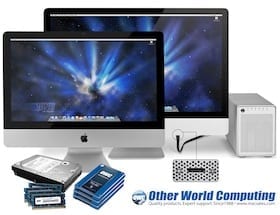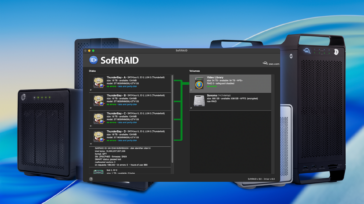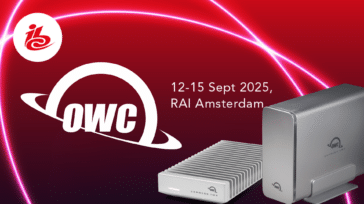 Other World Computing announced today a lower starting cost for installation of a 6Gb/s SSD via the OWC Turnkey Upgrade Installation Program for the Mid-2011 Apple iMac. Starting from less than half the cost of factory SSD options, the OWC program gives mid-2011 iMac owners/buyers the option of having OWC install up to three award winning, SandForce Driven OWC Mercury 6G Solid State Drives up to 480GB each and with data rates over 2x faster than factory SSD options. Program options also include a larger capacity hard drive up to 3.0TB and certified Memory Upgrades up to 32GB. 27″ iMac owners also have the option of OWC installing the industry’s only eSATA interface and experience data transfer rates up to 600MB/s. OWC’s installation service program offers multiple configuration options starting at $169 with a 48 business hours or less installation turnaround.
Other World Computing announced today a lower starting cost for installation of a 6Gb/s SSD via the OWC Turnkey Upgrade Installation Program for the Mid-2011 Apple iMac. Starting from less than half the cost of factory SSD options, the OWC program gives mid-2011 iMac owners/buyers the option of having OWC install up to three award winning, SandForce Driven OWC Mercury 6G Solid State Drives up to 480GB each and with data rates over 2x faster than factory SSD options. Program options also include a larger capacity hard drive up to 3.0TB and certified Memory Upgrades up to 32GB. 27″ iMac owners also have the option of OWC installing the industry’s only eSATA interface and experience data transfer rates up to 600MB/s. OWC’s installation service program offers multiple configuration options starting at $169 with a 48 business hours or less installation turnaround.
OWC Options Create A Better Than Factory Built 2011 iMac
Owners of a 2011 iMac can experience the following benefits from the OWC Upgrade Program and enjoy a superior performing iMac than what is available direct from the factory:
- Over Twice As Fast & Double The Capacity Solid State Drive
OWC Mercury 6G SSDs offer capacities up to 480GB, up to nearly double the capacity than the single factory 256GB SSD option, and offer read/write speeds in excess of 550MB/s…over twice the performance than the factory 3G speed limited SSDs. Support for a RAID-0 configuration allows data rates of up to 1GB/s (1000MB/s), nearly four times the data performance vs. factory options in available multi-SSD configurations. Depending on other options selected, up to three OWC Mercury 6G SSDs can be installed for a total of up to 1.44TB SSD capacity.
- More ‘Main Bay’ Storage Configuration Options
iMac owners requiring more storage capacity than the factory stock 500GB-1.0TB hard drive can have OWC replace it with up to a 3.0TB drive for up to 6X greater platter based storage. Or, instead of a traditional hard drive, OWC can add an additional OWC Mercury 6G SSD with up to 480GB capacity to the 3.5” drive bay
- Additional & Lower Cost Memory Options Than Factory
OWC can add up to 4X the factory maximum installed RAM with the OWC RAM 32GB option. Or, select from other OWC Memory Upgrade options providing 8GB total RAM starting from $80. For iMac owners only seeking a memory upgrade, OWC Memory Kits for the 2011 iMac are also available with savings up to 77% compared to factory upgrades and come backed by OWC’s free installation videos and lifetime support.
- Only eSATA Interface Option Offered For iMac
With fast data transfer rates up to 600MB/s, OWC’s external eSATA port option for the 2011 27” iMac lets users take advantage of plentiful and affordable eSATA external drives for data backups and transfers at up to 6X faster than the built in FireWire 800 interface.
“The goal of our Turnkey Upgrade Installation Program for iMacs is to offer customers the most comprehensive choices and support available for a ‘better than new’ iMac ownership experience,” said Larry O’Connor, Founder and CEO, Other World Computing. “Lowering the cost to get into a 6Gb/s SSD increases the opportunity for more iMac owners to unleash the full capability of these exceptional machines while applying those savings to adding more RAM or a larger hard drive to further maximize their iMac’s potential.”
For answers to frequently asked questions regarding the program, visit our FAQ.








Installed the Seagate SSHD in my iMac mid-2011 27″. Also, used the OWC In-line Digital Thermal Sensor cable. Then installed OS X Lion as that was the only way using Internet Recovery to install a new OS. Booted perfectly AND was lightning fast. Then, upon opening Migration Assistant to transfer Time Machine backed up files, it froze. So, had to force restart. Relaunched in single-user mode in case of damage to drive/permissions and tried /sbin/fsck-fy Received new messages in unix mode “enable drive PHY PM failed” and “0 [Level 3] [ReadUID 0]” Now, cannot even see the HD or do a normal start-up. Now, what do I do? Thinking I need to remove the Seagate SSHD, dock it, and repair using PC or MacBook. Any suggestions? It’s not very clear after you’ve installed drive, what steps are required to install OS, update drivers or firmware, etc.
Hello Logendra,
We would recommend to first run a PRAM Reset and SMC Reset on your computer. If you are still experiencing problems seeing the drive, please take the drive out, reformat and download a fresh install of the OS externally if possible.
If this does not work, please feel free to contact our Technical Support Team!
Hi,
Great news on the new turnkey program. Any chance European costumers could get in on that esata action?
We are big proponents of people upgrading their Macs themselves and our free ‘DIY’ Installation Videos support this. Certain aspects of this upgrade are and/or will be available for ‘DIY’, but certain options, such as the eSATA port and support for a third internal drive/eSATA + two internal drives, are of a complexity that is best supported with work performed by our Apple® Certified Technicians via our send in program. With the exception of upgrading the memory, which is a fully user supported installation, any drive installation inside the iMac is best done by an experienced technician.
We so ship worldwide, but please note additional shipping charges will apply for upgrades shipping to Alaska, Hawaii, or international locations. You can view estimated shipping costs with your checkout cart.
Is there any ETA on the DIY solutions? Will there be a solution for adding an SSD and for replacing the stock HD? Thanks.
I am sorry, but we cannot divulge information regarding the feasibility, development status or projected release date of future products. Stay tuned to the OWC Blog as when we do release new products and services, it will always be announced here first.
I would love to see a owc Elite pro mini with thunderbolt!!!!!!!
Any chance of a kit coming soon for those for whom shipping iMacs overseas isn’t affordable?
We’re planning to offer 3TB Hard Drive Kits and SSD Bay Kits that will allow an Apple Certified technician to install upgrades in your iMac without having to send it to us. More on that as things develop so again, just keep revisiting the Blog to learn about those details.
Please get a move on this. Thanks.
Hi Michael,
I am also very interested in a kit version since shipping an iMac overseas is very expensive.
I am glad you found a way to bypass Apple’s restictions in the 2011 iMac and would definitely order an expansion kit when it will become available. I am interested in putting 2 SSDs, a larger HDD and more RAM (all from OWC, of course) in a new 3.4GHz iMac that I need to buy locally to avoid the high shipping fees. I have access to a local Apple Certified Service that could install the upgrades in the new machine, so that would not be a problem.
Could you estimate a time frame? At least something like before year end versus next year?
Thank you!
I’m sorry, but we can’t divulge information regarding the feasibility, development status or projected release date of future products.
When we do come out with new products, they will always be announced here on the OWC Blog right away, so bookmark us to be among the first informed on new products from OWC and Newer Technologies.
For those who don’t want to cut a hole in their new iMac, I believe Sonnet will be coming out shortly with a TB to Express Card to eSATA dongle. Man a TB dongle… what a great idea.
http://eshop.macsales.com/item/Sonnet%20Technology/ECHOE34/
Very nice.
Any chance you guys are going to sell this…
http://www.magma.com/thunderbolt.asp
It made me forget all about that eSATA dongle. I got all excited because I started thinking about full blown SATA with port multiplication, then I thought oh wait, SAS! And then I thought, forget that, how about PCI SSDs!
Is this why your making us wait until next year? :)
The Sonnet idea is great – at a premium price. The Echo plus the Pro eSata card and the TB cable comes in at over $375. (Or a more reasonable $250 for the 1 port esata card). I am leaning toward this solution unless OWC can come up with a more visually appealing method of cutting and mounting the esata port on their upgrade. John Ives shudders when someone Dremels a hole in his lovely aluminum.
Its really a matter of options and needs. Not everyone needs a bootable external eSATA port – but the OWC Turnkey Upgrade Program is an option for those that do. The Echo is going to be a great product for those who need flexibility and a range of options in expansion.
Don’t forget, Bill, Apple is still the ONLY source for Thunderbolt cables…and your premium price sentiment is right on…these cables cost $50. That Sonnet adapter does not include the cable…so this adapter will be close to $200 with that required cable + cost of the Express34 eSATA card (anywhere from $20-$200) vs. $169 for our 6G eSATA option. To us then, not a very performance attractive or cost attractive option vs. just going 6G eSATA via our program.
Why do I say that? The performance of eSATA via an Express34 card will be in the 150-200MB/s range (so like 3G speed) at best vs. up to 600MB/s via our port option. Also – Express/34 eSATA cards do not, I believe, support booting…whereas the port we offer is fully bootable.
Correct me if I’m wrong, but you’d need at least 2 6G SSDs in a Raid 0 to actually get data moving at 600 MB/s. Even though you may get theoretical speeds of 1000 MB/s, your going to be bottlenecked by the 6G SATA connection.
I’ll go out on a limb here and say most people opting for the eSATA port are going to use it with a larger storage array that will more often then not contain regular HDs over SSDs. If that is the case, how many HDs in a Raid 0, would it take to get to an actual 600 MB/s? All things left to themselves, how fast can a normal HD push data? I would think that with the exception of many drives in a large Raid 0, the HDs themselves would bottleneck you even before the 6G eSATA port would.
I think sometimes this blog confuses theoretical speeds with speeds you can actually get. I’d request a little more clarification when comparing speeds.
However this leads me to my next question, other than extra capacity, why would I put two SSDs in a new iMac? With one I can almost max out the SATA connection at 500 to 550 MB/s, when I add the 2nd one in a RAID 0 perhaps, it may boost me from the 500/550 MB/s to 600 MB/s, but that isn’t really cost effective. I love how you guys benchmark everything… any chance you can give us some actual data for the new iMac with different SSD configurations?
Finally, Simtek makes a 6G eSATA express card that has read speeds of about 384 MB/s, and the latest express cards do support booting.
So.. will two SSDs (RAID 0) in an iMac be any faster than one? 600 MB/s is as fast as they can possibly go due to SATA, and one of the OWC drives can hit 500 to 550 MB/s, correct?
If a hard drive is attached to the computer via a direct TB link, will that bypass SATA? Is there any way for the iMac to get past the SATA bottleneck?
Any chance on some benchmarks for the new iMacs with the different SSD configs?
While we don’t have benchmarks available on the newer models yet, you can draw conclusions from the 2010 model benchmarks.
http://eshop.macsales.com/shop/turnkey/iMac_2010_27/benchmarks/
The 2010 iMacs had a SATA Revision 2.0 system bus (limited to 300 MB/s theoretical – and around 270 MB/s actual read write speeds by itself) When two were in a RAID 0, speeds almost doubled to 530-540MB/s actual transfer rates.
When you have a RAID 0 setup with two drives you are writing two channels simultaneously – so overall transfer speeds would be twice as fast.
So, yes, you can achieve speeds greater than 600MB/s by setting up an internal RAID 0 array across two 6G SSDs
I just got a 27″ i7 upgraded with 6G eSATA, 480GB Mercury Extreme Pro SSD, 3TB HD and 16GB RAM. The service was excellent and I would highly recommend it!